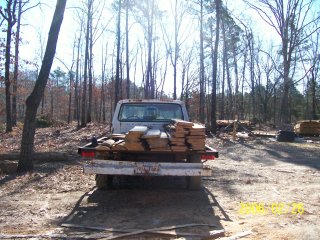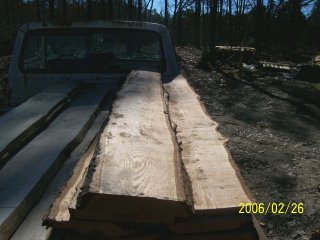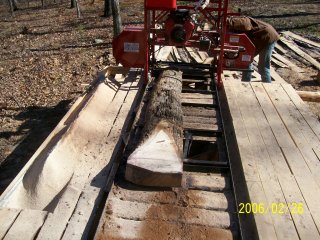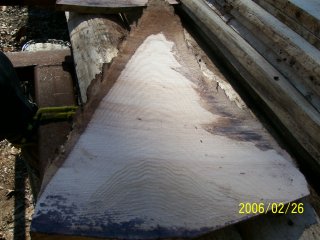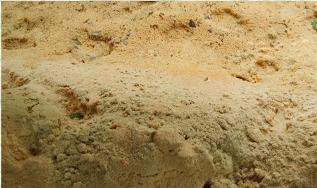Dust Gets in Your Eyes
The day began cloudy and windy, but that wasn't enough to keep us from cutting. After all, the loading ramp to the sawmill had been full for three weeks, so now the wait was over - it was time to saw our first hardwood.
We began the day by doing maintenance on Oscar. Greasing the bearings, making sure the saw blade was level and manually setting the guides for optimum use. Then, using BoardCalc, I guesstimated the number of board feet we had to cut from the logs on the ramp. We put a new blade on and we were set to go.
Our first two logs were 'blue' pine. The new blade slid through those like a knife in soft butter. As I watched the boards come off, I couldn't help but think that, because of the staining, those planks deserved something better than being covered up in a building project. Each board, pretty in its own right, had a character all its own.
The next log was the butt end of a large Post Oak. 17 inches on the small end and at least 24 inches on the butt. When I had entered this log into BoardCalc, I had inadvertently entered 12" instead of 17". So as Kevin wrestled what we thought was a 650 pound log into place on the rails, I was trying to determine how far down I would have to take the blade to reach the heart wood.
Once the log was loaded into place, I began my cut. Immediately, I knew this was a whole new ballgame. Gone was the butter principle of pine, this Post Oak was more like cutting raw onions. It took a bit of effort to push the blade through. I definitely had to slow down with this wood. Finally, Kevin was pulling off the largest slab of lumber I had cut. We both looked at the slab and knew we would be re-sawing it later, after we got the rest of the job done.
After we got the log canted, then it was just a matter of cutting the cant into even sized boards. We repeated the procedure with the next log. The job for the neighbor was now complete and it was time to move on to our Red Oak.
The one thing that struck me most about cutting Post Oak was how fine the sawdust was. With the wind blowing as hard as it was, I ended up having to change to a different type of safety glasses, just to keep the sawdust out of my eyes. It was blowing everywhere; on me, on Kevin, on the deck.
Kevin and I changed places; it was his turn to cut and my turn to buck the boards to the back of the truck. He still had to load the logs onto the deck, but switching off lets both of us use a different set of muscles for a while.
I was amazed as I pulled the Red Oak boards off the mill. Beyond beautiful is not quite expressive enough to describe how pretty these boards were. Already, I was envisioning a new coffee table in my living room made from this wood. Planning and sanding could only make it lovelier.
At the end of the day, we had done another 500 board feet. But we had learned a lot, not only how to better maintain the sawmill, also a bit about how different species of wood turned into boards.
Oh, and that tiny miscalculation I made for that one log - well - it was a little more than minor. That first Post Oak weighed well over a thousand pounds. Kevin and I both wonder, had we known that first, would we have even tried to load it onto the deck? Yeah, we would have. We both like a challenge.


